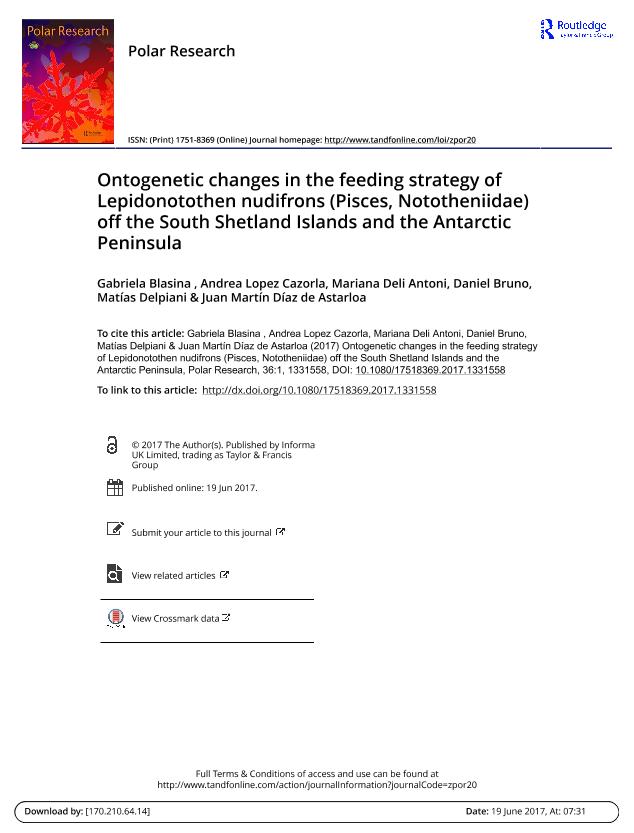Mostrar el registro sencillo del ítem
dc.contributor.author
Blasina, Gabriela Elizabeth

dc.contributor.author
Lopez Cazorla, Andrea Cecilia

dc.contributor.author
Deli Antoni, Mariana Yanel

dc.contributor.author
Bruno, Daniel Osvaldo

dc.contributor.author
Delpiani, Sergio Matias

dc.contributor.author
Díaz de Astarloa, Juan Martín

dc.date.available
2018-11-15T14:23:58Z
dc.date.issued
2017-06-01
dc.identifier.citation
Blasina, Gabriela Elizabeth; Lopez Cazorla, Andrea Cecilia; Deli Antoni, Mariana Yanel; Bruno, Daniel Osvaldo; Delpiani, Sergio Matias; et al.; Ontogenetic changes in the feeding strategy of Lepidonotothen nudifrons (Pisces, Nototheniidae) off the South Shetland islands and the Antarctic Peninsula; Wiley Blackwell Publishing, Inc; Polar Research; 36; 1; 1-6-2017; 1-8
dc.identifier.issn
0800-0395
dc.identifier.uri
http://hdl.handle.net/11336/64514
dc.description.abstract
The diet and feeding strategy of Lepidonotothen nudifrons off the South Shetland Islands and the Antarctic Peninsula, as well as their variation in relation to ontogenetic stage (juvenile– adult) and sampling area, were determined by stomach contents analysis. Additionally, the trophic level of this species was estimated to determine its position within the Antarctic food web. Out of 247 specimens with prey in their stomachs, 144 were caught near the South Shetland Islands and 103 off the Antarctic Peninsula. Ontogenetic changes in the trophic ecology of L. nudifrons were observed in both areas and were mainly related to a decrease of copepods and an increase of euphausiids in the diet. The diet of juveniles from the South Shetland Islands was characterized by the dominance of calanoid copepods, followed by isopods and amphipods, whereas diet off the Antarctic Peninsula was dominated by amphipods and cyclopoid copepods. The diet in adults was dominated by amphipods and euphausiids in both areas. The specialization of individual predators on different prey types was observed when considering the whole population of L. nudifrons, but when ontogenetic stages were considered separately it showed a more mixed feeding strategy, with different dominant prey for each class. Although the trophic level increased with fish size, L. nudifrons can be classified as secondary consumer throughout its lifespan.
dc.format
application/pdf
dc.language.iso
eng
dc.publisher
Wiley Blackwell Publishing, Inc

dc.rights
info:eu-repo/semantics/openAccess
dc.rights.uri
https://creativecommons.org/licenses/by-nc-sa/2.5/ar/
dc.subject
Antarctic Fish Diet
dc.subject
Dominant Prey
dc.subject
Feeding Strategy
dc.subject
Food Web
dc.subject
Trophic Level
dc.subject
Zonerelated Changes
dc.subject.classification
Otras Ciencias Biológicas

dc.subject.classification
Ciencias Biológicas

dc.subject.classification
CIENCIAS NATURALES Y EXACTAS

dc.title
Ontogenetic changes in the feeding strategy of Lepidonotothen nudifrons (Pisces, Nototheniidae) off the South Shetland islands and the Antarctic Peninsula
dc.type
info:eu-repo/semantics/article
dc.type
info:ar-repo/semantics/artículo
dc.type
info:eu-repo/semantics/publishedVersion
dc.date.updated
2018-10-19T20:42:01Z
dc.identifier.eissn
1751-8369
dc.journal.volume
36
dc.journal.number
1
dc.journal.pagination
1-8
dc.journal.pais
Reino Unido

dc.journal.ciudad
Londres
dc.description.fil
Fil: Blasina, Gabriela Elizabeth. Consejo Nacional de Investigaciones Científicas y Técnicas. Centro Científico Tecnológico Conicet - Bahía Blanca. Instituto Argentino de Oceanografía. Universidad Nacional del Sur. Instituto Argentino de Oceanografía; Argentina. Universidad Nacional del Sur. Departamento de Biología, Bioquímica y Farmacia; Argentina
dc.description.fil
Fil: Lopez Cazorla, Andrea Cecilia. Consejo Nacional de Investigaciones Científicas y Técnicas. Centro Científico Tecnológico Conicet - Bahía Blanca. Instituto Argentino de Oceanografía. Universidad Nacional del Sur. Instituto Argentino de Oceanografía; Argentina. Universidad Nacional del Sur. Departamento de Biología, Bioquímica y Farmacia; Argentina
dc.description.fil
Fil: Deli Antoni, Mariana Yanel. Consejo Nacional de Investigaciones Científicas y Técnicas. Centro Científico Tecnológico Conicet - Mar del Plata. Instituto de Investigaciones Marinas y Costeras. Universidad Nacional de Mar del Plata. Facultad de Ciencias Exactas y Naturales. Instituto de Investigaciones Marinas y Costeras; Argentina
dc.description.fil
Fil: Bruno, Daniel Osvaldo. Consejo Nacional de Investigaciones Científicas y Técnicas; Argentina. Laboratorio de Ecología, Fisiología y Evolución de Organismos Acuáticos; Argentina
dc.description.fil
Fil: Delpiani, Sergio Matias. Consejo Nacional de Investigaciones Científicas y Técnicas. Centro Científico Tecnológico Conicet - Mar del Plata. Instituto de Investigaciones Marinas y Costeras. Universidad Nacional de Mar del Plata. Facultad de Ciencias Exactas y Naturales. Instituto de Investigaciones Marinas y Costeras; Argentina
dc.description.fil
Fil: Díaz de Astarloa, Juan Martín. Consejo Nacional de Investigaciones Científicas y Técnicas. Centro Científico Tecnológico Conicet - Mar del Plata. Instituto de Investigaciones Marinas y Costeras. Universidad Nacional de Mar del Plata. Facultad de Ciencias Exactas y Naturales. Instituto de Investigaciones Marinas y Costeras; Argentina
dc.journal.title
Polar Research

dc.relation.alternativeid
info:eu-repo/semantics/altIdentifier/doi/https://doi.org/10.1080/17518369.2017.1331558
dc.relation.alternativeid
info:eu-repo/semantics/altIdentifier/url/https://www.tandfonline.com/doi/full/10.1080/17518369.2017.1331558
Archivos asociados
